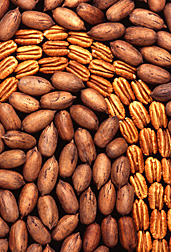This page has been archived and is being provided for reference purposes only. The page is no longer being updated, and therefore, links on the page may be invalid.
| Read the magazine story to find out more. |
|
|
|
|
Nickel and Phosphite Help Growers Fight Pecan Scab
By Sharon DurhamAugust 19, 2013
Adding nickel and phosphite to an existing fungicide spray regimen may help growers thwart pecan scab, a scourge to pecan growers in Georgia, according to U.S. Department of Agriculture (USDA) scientists.
Pecan scab, caused by the fungus Fusicladium effusum, is the most destructive disease of pecan in the southeastern United States. When scab is severe—most often due to above-average rainfall—it reduces nut size and can even wipe out a season's crop.
Scientists at the Agricultural Research Service (ARS) Southeastern Fruit and Tree Nut Research Laboratory in Byron, Ga., are helping pecan growers mitigate the effect of pecan scab. Research leader Bruce Wood, plant pathologists Clive Bock and Michael Hotchkiss, and entomologist Ted Cottrell are using nickel and phosphite treatments and other approaches to reduce scab's impact.
ARS is USDA's chief intramural scientific research agency, and this research supports the USDA priority of promoting international food security.
Wood and his colleagues determined that spraying canopies with nickel not only improves tree health and increases tree resistance to scab, but also imparts a beneficial side effect of reducing growth and proliferation of the fungus. They found that combining nickel as a nutritional supplement with fungicides and applying them as air-blast sprays helped reduce losses in commercial orchards.
Bock and his colleagues found that phosphite controlled pecan scab on both foliage and fruit early in the growing season. It also reduced disease on mature pecans, but not as well as an industry standard fungicide, triphenyltin hydroxide. However, scab on fruit late in the season is cosmetic and was previously shown by ARS scientists to have no effect on nut quality or yield.
In field tests, phosphite was directly toxic to the pecan scab fungus at concentrations similar to those in the lab. Phosphite provides an alternative chemistry for growers to consider, according to Bock. This is particularly useful because the scab fungus has developed resistance to some fungicides currently used for control.
Read more about this research in the August 2013 issue of Agricultural Research magazine.

